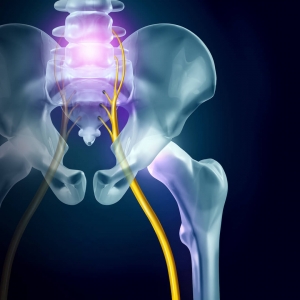Nerve Pain With Sciatica: What It Is and How We Approach Sciatic Treatment in Victoria BC
Ouch! Have you ever experienced a sharp, shooting, burning or pinching pain down your lower back, glutes, hamstrings or calves? Or how about a sudden and severe “electric jolt” like feeling following activity? While nerve pain with sciatica can be severe, it can also manifest as a mild, aching pain that seems to come and go. Some people experience sciatica as a weakness and numbness in the affected area. When nerve pain with sciatica becomes severe, it’s nearly impossible to ignore. When patients arrive at our clinic, it’s often because their sciatica pain is interfering with their ability to enjoy their usual activities, including work, rest, and recovery.
First, What is Nerve Pain With Sciatica?
 Sciatica is the term used to describe sciatic nerve pain. Nerve pain can occur anywhere in the body while sciatic nerve pain affects the lower back and lower, posterior extremities. This is because of how the sciatic nerve branches off your lower spine (just above your buttocks) before threading down through your glutes, hamstrings and calves. Sciatic nerve pain often occurs on one side of the body, or is markedly worse on one side of the body, and can arise from various physical triggers as outlined below.
Sciatica is the term used to describe sciatic nerve pain. Nerve pain can occur anywhere in the body while sciatic nerve pain affects the lower back and lower, posterior extremities. This is because of how the sciatic nerve branches off your lower spine (just above your buttocks) before threading down through your glutes, hamstrings and calves. Sciatic nerve pain often occurs on one side of the body, or is markedly worse on one side of the body, and can arise from various physical triggers as outlined below.
Nerve pain with sciatica occurs when a nerve is pinched, which can be caused by a myriad of contributing factors, including:
- Obesity
- Inflammation
- Poor posture
- Chronically tight or strained muscles
- Short and tight hip flexor and hamstring muscles
- Spinal bone spurs and overgrowths
- Herniated disc
- Incorrect form during exercise
- Occupational strain
- Following an accident or injury
- Tumor growth
- Complications of underlying diseases such as diabetes.
Things You Can Do to Help Prevent Nerve Pain with Sciatica
You can help reduce your chances of developing pinched nerves by establishing good physical habits, including:
Regular Exercise & Stretching
Making time in your week for adequate fitness and activity with a focus on consistency, proper form, stretching, and sufficient recovery. If you’re new to a workout or activity, consider getting help from one of our physiotherapists to ensure you are performing each move with proper form to avoid pinching nerves or overstraining your spine. This is especially important if you have any pre-existing injuries. Everybody is different: An exercise that works fine for your friend, may not work as well for you, and gym and sports equipment should be adjusted to fit your specific body dynamics–this includes proper footwear!
Maintaining Good Posture
Be mindful of your posture while sitting, standing, lifting and otherwise exerting your body. This includes assessing the ergonomics of your seating and workstation arrangement. Subtle adjustments can make the difference between a happy body versus one riddled with muscle tightness, inflammation, nerve pain, and injury.
Adequate Rest and Recovery
Athletes know that adequate recovery is just as critical as being active, but rest is often the first thing people take for granted. Good recovery starts with knowing when your body needs rest and giving it the support it requires to repair itself and grow stronger. This includes steps such as good nutrition, icing, rolling, and massage to help reduce inflammation. It also includes how you sleep.
Support While You Sleep
There’s a science to choosing the right pillow. Make sure your pillow has the right density and height, according to your preferred sleeping position. You want to maintain the natural curvature in your neck. It also helps to take the pressure off your lower back and hips by placing a rolled-up towel or pillow behind the crook of your knees (when laying on your back) or between your bent knees (when laying on your side). The idea is to keep your knees slightly bent in order to maintain a very slight natural curve in your lower back. This also helps to relax tight hip flexors, glutes, and hamstrings.
Supporting your spinal health during work, rest and sleep can be a pretty significant game-changer. A physiotherapist can demonstrate specific stretches and techniques you can use at work and at home to relieve nerve pain with sciatic and support your recovery.
Pain Indicates It’s Time to Seek Treatment
Ignoring nerve pain is never a good idea. Consider that pain is your body’s way of communicating that something isn’t as it should be. Neglecting to address the pain and the cause of it can result in compounding complications or even permanent nerve damage. Being proactive is key. The good news is that sciatica pain can often be resolved with non-invasive treatments that target the root causes of pinched nerves and prevent the pain from coming back.
Relieving Nerve Pain with Sciatica: Sciatic Treatment in Victoria, BC:
Because pain can be caused by a variety of factors that are unique to your situation, at Diversified Health Clinic, we take a comprehensive approach to treating nerve pain with sciatica. We start with a thorough initial consultation before tailoring a treatment plan for you that’s based on the specific causes of your pain. Your treatment plan may include one or more of the following treatments and will include tips on how you can maintain your results at home between appointments.
- Chiropractic Care
- Physiotherapy and Intramuscular Stimulation
- Registered Massage Therapy
- eToims Needle-less Intramuscular Stimulation
- Laser Therapy
- Ultrasonic Shockwave Therapy
- Spinal Decompression
- Orthotics
Depending on the cause and severity of sciatica and nerve pain, patients often start feeling relief after the first visit, which only gets better as the treatments progress. It brings us tremendous satisfaction to see our patients return to their favourite activities and lifestyles without the hindrance of pain and fatigue. Life is too precious to spend it in unnecessary pain, especially when effective treatments are within reach.
If you suffer from the symptoms of nerve pain with sciatica, give our team of practitioners a call at Diversified Health Clinic today at (250) 382-0018 or book an appointment online. We’re happy to help answer your questions, address the cause of your pain and discomfort, and get you on the road to recovery.





